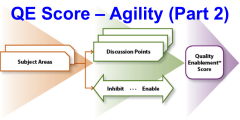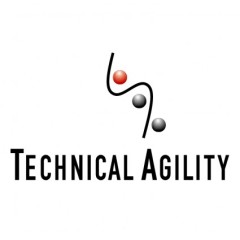… Can be Measured (Agility Dimension) – Part 2 of 2

“Start with nothing. When that’s not enough, try the simplest possible way to provide whatever you need. Repeat.”
Ron Jeffries
Today, we’ll continue our discussion with the details of the Agility Dimension’s Subject Areas and Discussion Points, part 2. For a review of the Agility Dimension, click here.)
We covered the first 4 Subject Areas last week; we’ll discuss the remaining 4 this week.
As we’ve done previously, I’ve included the weight (e.g. [3]) and guidelines for scores of 1, 4, and 7. Those that are purely inhibiting are tagged with “(inhibiting)” and only have guidelines for 1 & 4; likewise, those that are purely enabling are tagged with “(enabling)” and only have guidelines for 4 & 7.
QE Score Assessment – Agility Dimension – Part 2
Decision-making

- How are changes to project plans or designs decided / approved? [4]
1 – A few key people make the decisions
4 – We get most stakeholder groups involved, but the process can take too long
7 – Decisions are made quickly by empowered stakeholder representatives
- How empowered are the individual teams? [4]
1 – Not at all
4 – Teams are reasonably empowered to make changes within tight organizational guidelines
7 – The teams are highly empowered to make decisions that impact them
Process Oversight

- How much flexibility do the teams have specifically with their processes? [4]
1 – None
4 – Teams are reasonably empowered to make process changes within tight organizational guidelines
7 – The teams are highly empowered to make process decisions that impact them, and can quickly resolve inter-team process changes
- Are there organizations (e.g. PMO) that inhibit team process flexibility? (inhibiting) [4]
1 – Yes – We are significantly burdened by ____ group
4 – None
- If other organizations inhibit agility, how do they do that? (inhibiting) [4]
1 – They restrict process change, require too much time to provide them information, etc.
4 – N/A
Adoption Support

- When agile was introduced, who provided the agile expertise? [3]
1 – We figured it out on our own
4 – We hired coaches to “train the trainers” who then trained the rest of us
7 – We used highly experienced coaches (internal or external)
- With what groups did they meet? [4]
1 – N/A
4 – They met with the key implementers, but not all stakeholders
7 – They met with all stakeholder groups
- What training / mentoring did they provide? [5]
1 – None
4 – Train the trainer, no on-going mentoring
7 – They trained all stakeholder groups and provided mentoring until we were able to be self-sufficient
- How does the annual performance review process impact agility? [3]
1 – It inhibits sharing and teamwork
4 – No real impact
7 – We’ve modified the process to encourage agility across the organization
- Do you get sufficient support from facilities? [3]
1 – No
4 – They’re OK, but they still don’t understand what we need as agile teams
7 – Yes – they’re responsive to the changing needs of an agile organization
- Are there other factors that inhibit agility? What are they? (inhibiting) [3]
1 – Many … get list
4 – None
Technical Agility Support

- How complete are requirements prior to iteration start? [3]
1 – Requirements are fully defined, down to design-level specs
4 – Business requirements fairly defined, but design is up to team
7 – Enough to get us started, and the business steers development as we build the solution
- How much interaction is there with the business owner? [4]
1 – None
4 – They provide requirements at the beginning of the iteration, and review deliverables when complete
7 – Daily at minimum, intra-day as needed
- How does the technology infrastructure enable agility? [3]
1 – The infrastructure actually inhibits our ability to be agile
4 – The infrastructure neither inhibits nor enables agility
7 – The current infrastructure fully supports our efforts to implement agile development
What’s Next
Next week, we’ll discuss the Management Style Dimension’s contribution to the QE Score.
Until Then …
“The more power you have, the more important it is to exercise that power collaboratively.”
Thomas A. Stewart

What are your thoughts? Please share your comments in the block below.